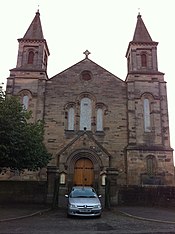Polmont
|
Polmont Scottish Gaelic Poll Mhonadh Scots Powmont |
||
|---|---|---|
| View over Polmont | ||
| Coordinates | 55 ° 59 ′ N , 3 ° 42 ′ W | |
|
|
||
| Residents | 5322 (as of 2011) 2011 census | |
| surface | 2.0 km² (0.77 mi² ) | |
| Population density: | 2661 inhabitants per km² | |
| administration | ||
| Post town | FALKIRK | |
| ZIP code section | FK2 | |
| prefix | 01324 | |
| Part of the country | Scotland | |
| Lieutenancy Area | Stirling and Falkirk | |
| Council area | Falkirk | |
| British Parliament | Falkirk | |
| Scottish Parliament | Falkirk East | |
Polmont ( Scottish Gaelic : Poll Mhonadh ) is a small town in Scotland . It is located about five kilometers south of the town of Grangemouth and about ten kilometers east of the town of Falkirk in the Falkirk Council Area . Polmont is right on the M9 motorway . The village has 5322 inhabitants.
Lord Polmont is a subsidiary title of the Duke of Hamilton . This title was originally bestowed on the 2nd Duke of Hamilton in 1639.
history
The name Polmont is derived from the Scottish Gaelic term Poll-Mhonadh, which is translated in English as "Pool of the Hill", or from "Brittonic pol mönïδ", the fire (brook) on the hill (or promontory). This area was part of the post-Roman kingdom of Gododdin , which was formed by a British tribe. They settled in what is now northeastern England and southeastern Scotland at the end of the Roman era.
Old Polmont was elevated on a hill overlooking the Firth of Forth and the Ochil Hills . There were two Roman temporary marching camps, one on either side of what is now Grangemouth Golf Course and on the east side of Polmont Hill. Nearby, at Mumrills, was the largest fortress on the Roman Antonine Wall . The fort, dam and water source are now appropriately marked and can be viewed in Polmont Woods near the M9 motorway.
Polmont originally belonged to the parish of Falkirk and was appointed an independent parish in 1724 by a court order by the Court of Teinds (teind is the Scottish word for tithe).
During the Second World War, the now demolished “St. Margaret's School for Girls “used by the Polish armed forces as a signal training school and soldiers from various Polish units had to learn how to use signaling devices here.
traffic
Polmont has a train station and rail links to the Edinburgh - Glasgow line .
The M9 motorway runs near the village. There are two exits between Polmont and Old Polmont: on the east and west side. There are numerous bus stops throughout the village, preferably on the main road, with direct bus services to Edinburgh, Falkirk and Stirling . The nearest airport, Edinburgh Airport, is approximately 17 miles to the east.
economy
Polmont's economy is largely based on relatively small private businesses such as pubs, cafes, hotels, kiosks, and general stores. Most of these are in or around the Polmont Shopping Center, the hub of local activity. Agriculture is also a central branch of the economy, with arable farming and pasture farming being the main uses. Polmont is home to the controversial Avondale landfill , a major employer in the east of the town.

Due to its proximity to Grangemouth , part of the population works in the refineries and in the port of this city, but many also commute to Edinburgh and Glasgow . Only a small part of the population works directly in Polmont.
sport and freetime
The amateur football club "Polmont FC" is located in Polmont. Scottish international Alex Raisbeck was born in Polmont and was the captain of Liverpool FC for several years . He led Liverpool to his very first English league title in 1901 and did so again five years later. He was considered one of the best players of his generation from 1898. A commemorative trophy named after Raisbeck is awarded annually by "Polmont FC".
Despite its name, the "Grangemouth Golf Club" is on the outskirts of Polmont. Ironically, there is also a Polmont Golf Club that is not in Polmont, but in nearby Maddiston. Within the limits of the Grangemouth Golf Club is the Millhall Reservoir, a fishing center of the Avonbank Fishing Club. To the east is the “Polmont Ski Center” with an artificial ski slope.
Polmont has a primarily Christian parish and parish church (Polmont Old Parish Church) designed by architect John Tait in 1844. There is also the Church of the Brethren and the Religious Society of Friends .
Personalities
- Gilbert Laurie von Polmont (1729–1809), 1766 to 1768 and from 1772 to 1774 he was Lord Mayor of Edinburgh
- Johan Theodor Salvesen (1820–1865), co-founder of the whaling shipping company Christian Salvesen
- Alex Raisbeck (1878–1949), soccer player and coach, played in the Scottish national team from 1900 to 1907
Web links
Individual evidence
- ^ Information from the Scottish Parliament
- ↑ Population figures at citypopulation.de, accessed on May 27, 2019.
- ↑ Polmont at maps.nls.uk, accessed on May 27, 2019.
- ↑ Order survey at maps.nls.uk, accessed on May 27, 2019.
- ^ Atlas of Scotland, 1832 at maps.nls.uk, accessed on May 27, 2019.
- ↑ Club website at clubwebsite.com, accessed on May 27 of 2019.
- ↑ Archived copy via Alex Raisbeck from liverpoolfc.tv, accessed May 27, 2019.
- ↑ Grangemouth Golf Club official website at scottishgolfcourses.com, accessed May 27, 2019.
- ↑ Polmont Ski Center on visitscotland.com, accessed May 27, 2019.
- ^ Polmont Old Parish Church at polmontold.org, accessed May 27, 2019.
- ^ Works by John Tait at scottisharchitects.org, accessed May 27, 2019.
- ↑ Quakers in Scotland at quakerscotland.org, accessed May 27, 2019.




